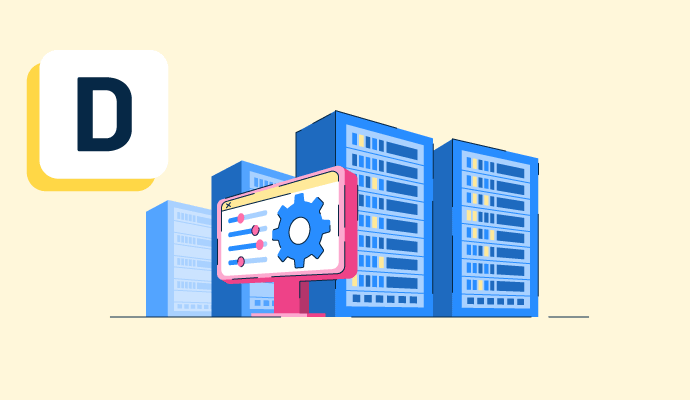What is DCIM?
Data center infrastructure management (DCIM) is the comprehensive process of managing and optimizing an organization’s data centers and infrastructure. DCIM comprises the tools, guidelines, and methods required for managing data center utilization and IT infrastructure, including software and hardware.
Enterprise organizations use data center infrastructure management (DCIM) software to organize, manage, and monitor the components of their data centers. This software facilitates asset management, performance monitoring, and hardware maintenance. DCIM software provides an all-in-one solution for managing multiple data centers.
Types of DCIM software
Organizations can choose from one of two types of DCIM software depending on their specific needs and operational goals.
- Traditional DCIM software provides on-premise data monitoring and reporting. It manages and reports asset performance, ensuring efficient energy and bandwidth utilization across the organization’s resources. IT administrators can handle changes, capacity, and assets while reducing downtime and mitigating risks for smoother operations.
- Next-generation DCIM software performs the same functions as traditional DCIM software while being hosted in a cloud. It provides additional functionality unavailable on-premises. Next-generation DCIM software makes disaster recovery more accessible through the cloud.
Components of DCIM
DCIM components will vary based on the organization’s needs and the selected solution provider. The standard components of a DCIM solution include:
- Asset inventory: A critical component of the correct DCIM solution is the ability to catalog and track all physical assets in the data center. These assets include servers, storage devices, and network equipment. Adequate asset inventory helps organizations understand what equipment they have and might need for scalability.
- Power management and energy efficiency: DCIM tools can help teams understand their power consumption and energy management, identifying areas of opportunity to become more energy efficient.
- Capacity planning: Data centers require physical space for equipment and necessary assets to run effectively. DCIM software helps IT teams visualize rack and floor space utilization and plan for future space requirements based on desired growth.
- Network management: It’s beneficial to map data center networks, including network paths, for a comprehensive view of network functionality. Additionally, teams can monitor network performance and bandwidth utilization under network management.
- Change management: Changing data center environments can cause issues if done improperly. DCIM solutions with change-tracking capabilities can help IT teams understand the full impact of potential changes and record previous changes for historical knowledge reference.
- Real-time monitoring: Continuous monitoring enables teams to proactively prevent disruptions by identifying abnormal patterns and potential issues.
Benefits of DCIM
DCIM offers many benefits to organizations by providing a holistic and integrated approach to managing data center resources. Some key benefits include:
- Improved operational efficiencies: Since DCIM provides real-time monitoring and better visibility into data center performance, IT teams can use this information to identify inefficiencies and adjust them accordingly.
- Cost-savings: Optimizations, especially for power, cooling, and space utilization, lead to efficient practices and reduced operational costs. Additionally, organizations can leverage DCIM software to prevent or identify potentially unnecessary hardware investments for more savings.
- Better utilization of resources: DCIM software provides asset management features to help organizations track their physical resources and avoid over-utilizing equipment.
- Faster problem detection: Teams can quickly identify problems and issues with their data center operations using DCIM software, which means they can address them before they become detrimental. The ability to manage and fix problems early leads to smoother business operations.
Challenges of DCIM
Despite the benefits of leveraging DCIM software, organizations should be aware of potential risks before adopting it as a solution for their data center operations management. The key challenges include:
- Implementation complexities: Implementing DCIM solutions is time-consuming and intricate since it involves data center environments, the organization’s legacy systems, and other hardware and software. Teams may need additional internal or third-party resources to achieve the desired results.
- Integration with existing systems: Many organizations’ data centers include different types of equipment, including legacy systems, modern equipment, or a combination of both. DCIM solutions might not always be compatible with the equipment a business uses, causing significant challenges in the integration process.
- Significant upfront costs: The upfront costs of a DCIM solution, which include purchasing hardware, software, third-party professional services, and internal hiring, are substantial. Organizations must carefully evaluate whether they have the budget to justify the upfront costs and if the investment will benefit the organization over time.
- Not suitable for all organizations: Due to the high costs associated with implementing DCIM software, it’s not a solution that works well for organizations of all sizes. Smaller organizations with lower storage and data needs won’t receive the same return on investment from DCIM software that an enterprise organization will because they can manage their operations without it.
Follow data center design best practices to transform a physical space into an efficient data center facility.

Alyssa Towns
Alyssa Towns works in communications and change management and is a freelance writer for G2. She mainly writes SaaS, productivity, and career-adjacent content. In her spare time, Alyssa is either enjoying a new restaurant with her husband, playing with her Bengal cats Yeti and Yowie, adventuring outdoors, or reading a book from her TBR list.

